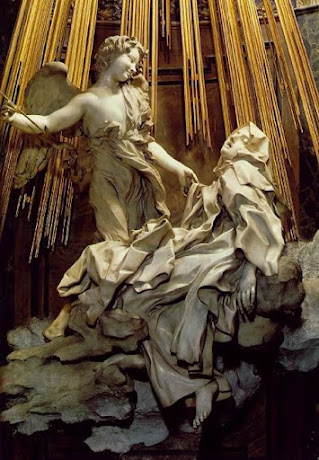About The PieceThe Artist
Gian Lorenzo Bernini was an Italian sculptor and architect that dominated the Roman art world during the seventeenth century (White, Veronica). The first workshop that Bernini was trained in was that of his father Pietro, where he assisted in creating sculptures. A few of Bernini's most famous works include Apollo and Daphne and The Statue of David (White, Veronica). Another sculpture of Bernini's that was very famous, especially for being in the baroque style, was The Ecstasy of Saint Teresa.
The Sculpture
The Ecstasy of Saint Teresa was carved by Bernini during 1647-1652 in Cornaro Chapel, Santa Maria della Vittoria, Rome (Ecstasy of Saint Teresa). This beautiful sculpture by Bernini portrays the Saint's overpowering sense of spiritual pleasure in serving Christ (Ecstasy of Saint Teresa). The imagery that Bernini uses suggests a more sensual pleasure being felt but this is done in order to convey the experience that Teresa had, which was the manifestation of her love for God and her spiritual union with him (Ecstasy of Saint Teresa).
Presentation & Elements
Light
The use of lighting and different values being created by this light along with the placement of this sculpture help to portray and enhance the form of the sculpture. The lighting highlights certain aspects of the piece, such as Saint Teresa's face and the angels face in order to point these areas out to the viewer so they can feel and understand the emotions that Bernini was trying to portray.
Texture
Texture is also used pretty heavily in this piece in several ways. To give the texture in the feathers of the angels wings, to create the texture in the fabric of the clothing and in the angels hair. The wooden panels that are coming down behind the sculpture help add more texture and dimension to the piece. I also feel that it adds more to the overall feeling of the piece.
Emotions
The emotion that this sculpture illuminates is that of a great spiritual bliss that is felt by Saint Teresa. The angel holding the spear represents this divine love that Saint Teresa is feeling (Ecstasy of Saint Teresa). You can see the bliss that Saint Teresa is feeling in this art and you can also see the caring and assuring expression on the angels face.
Influences
The Council of Trent
With the ideal of using art to serve as a means of stimulating the public's faith in the church (How Did Baroque Art and Architecture Come about?). From this ideal, the baroque style of art was created which was both sensual and spiritual. Not only is this sculpture the perfect example of a baroque style sculpture, it is widely known for being made in this style. The sculpture embodies and displays in great detail one of the most important moments in a saints, in this case Saint Teresa's, life.
Citations
“Ecstasy of Saint Teresa (1647-52) Cornaro Chapel, Santa Maria Della Vittoria, Rome.” Ecstasy of Saint Teresa by Bernini: Composition, Meaning, http://www.visual-arts-cork.com/sculpture/ecstasy-of-saint-teresa.htm#:~:text=The%20sculpture%20portrays%20the%20Saint's,for%20spiritual%20union%20with%20him.
“How Did Baroque Art and Architecture Come about?” Encyclopædia Britannica, Encyclopædia Britannica, Inc., https://www.britannica.com/question/How-did-Baroque-art-and-architecture-come-about#:~:text=Contending%20with%20the%20spread%20of,was%20both%20sensuous%20and%20spiritual.
“What Is Art Sculpture? the 4 Basic Types of Sculpture.” Eden Gallery, https://www.eden-gallery.com/news/what-is-art-sculpture#:~:text=What%20Are%20the%20Elements%20of,or%20all%20of%20these%20elements.
White, Veronica. “Gian Lorenzo Bernini (1598–1680): Essay: The Metropolitan Museum of Art: Heilbrunn Timeline of Art History.” The Met's Heilbrunn Timeline of Art History, 1 Jan. 1AD, https://www.metmuseum.org/toah/hd/bern/hd_bern.htm.


I recently learnt about this piece in my Art History class! It's a gorgeous piece, and the amount of detail in it is stunning. I especially enjoy the extra work that went into it with the theatre boxes and their occupants on either side, and the stage-like structure around the central figures. I also find this piece interesting because of it's mixture of pleasure and religion, something that isn't often seen in Christian/Catholic pieces.
ReplyDelete